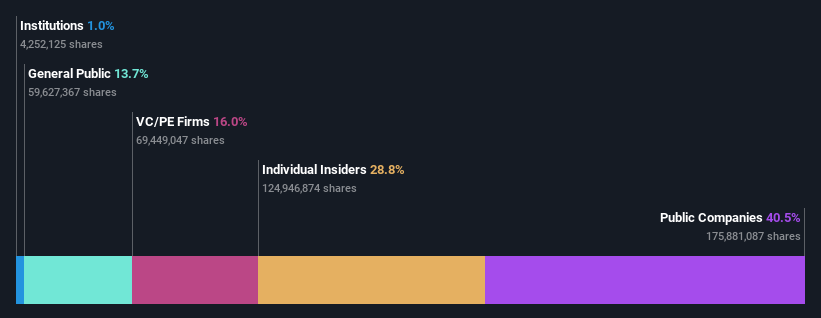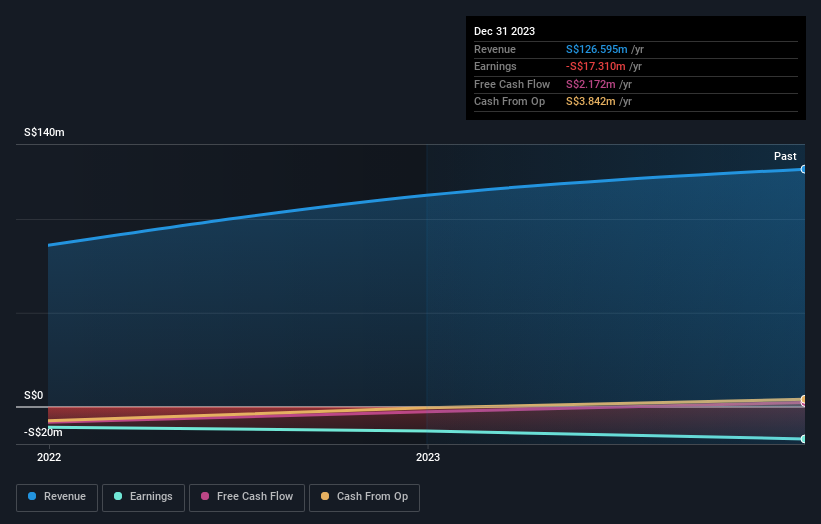Public companies invested in Synagistics Limited (HKG:2562) up 26% last week, insiders too were rewarded
Key Insights
- The considerable ownership by public companies in Synagistics indicates that they collectively have a greater say in management and business strategy
- A total of 2 investors have a majority stake in the company with 50% ownership
- 29% of Synagistics is held by insiders
If you want to know who really controls Synagistics Limited (HKG:2562), then you'll have to look at the makeup of its share registry. We can see that public companies own the lion's share in the company with 41% ownership. Put another way, the group faces the maximum upside potential (or downside risk).
Following a 26% increase in the stock price last week, public companies profited the most, but insiders who own 29% stock also stood to gain from the increase.
Let's delve deeper into each type of owner of Synagistics, beginning with the chart below.
Check out our latest analysis for Synagistics

What Does The Lack Of Institutional Ownership Tell Us About Synagistics?
Institutional investors often avoid companies that are too small, too illiquid or too risky for their tastes. But it's unusual to see larger companies without any institutional investors.
There are many reasons why a company might not have any institutions on the share registry. It may be hard for institutions to buy large amounts of shares, if liquidity (the amount of shares traded each day) is low. If the company has not needed to raise capital, institutions might lack the opportunity to build a position. On the other hand, it's always possible that professional investors are avoiding a company because they don't think it's the best place for their money. Synagistics might not have the sort of past performance institutions are looking for, or perhaps they simply have not studied the business closely.

Synagistics is not owned by hedge funds. Looking at our data, we can see that the largest shareholder is Alibaba Group Holding Limited with 34% of shares outstanding. For context, the second largest shareholder holds about 16% of the shares outstanding, followed by an ownership of 15% by the third-largest shareholder. Shieh-Peen Lee, who is the third-largest shareholder, also happens to hold the title of Chairman of the Board. In addition, we found that Ho Yan Tai, the CEO has 5.7% of the shares allocated to their name.
To make our study more interesting, we found that the top 2 shareholders have a majority ownership in the company, meaning that they are powerful enough to influence the decisions of the company.
While it makes sense to study institutional ownership data for a company, it also makes sense to study analyst sentiments to know which way the wind is blowing. Our information suggests that there isn't any analyst coverage of the stock, so it is probably little known.
Insider Ownership Of Synagistics
The definition of an insider can differ slightly between different countries, but members of the board of directors always count. The company management answer to the board and the latter should represent the interests of shareholders. Notably, sometimes top-level managers are on the board themselves.
I generally consider insider ownership to be a good thing. However, on some occasions it makes it more difficult for other shareholders to hold the board accountable for decisions.
Our most recent data indicates that insiders own a reasonable proportion of Synagistics Limited. It has a market capitalization of just HK$13b, and insiders have HK$3.8b worth of shares in their own names. That's quite significant. Most would say this shows a good degree of alignment with shareholders, especially in a company of this size. You can click here to see if those insiders have been buying or selling.
General Public Ownership
With a 14% ownership, the general public, mostly comprising of individual investors, have some degree of sway over Synagistics. While this group can't necessarily call the shots, it can certainly have a real influence on how the company is run.
Private Equity Ownership
Private equity firms hold a 16% stake in Synagistics. This suggests they can be influential in key policy decisions. Some investors might be encouraged by this, since private equity are sometimes able to encourage strategies that help the market see the value in the company. Alternatively, those holders might be exiting the investment after taking it public.
Public Company Ownership
Public companies currently own 41% of Synagistics stock. We can't be certain but it is quite possible this is a strategic stake. The businesses may be similar, or work together.
Next Steps:
While it is well worth considering the different groups that own a company, there are other factors that are even more important. For instance, we've identified 2 warning signs for Synagistics that you should be aware of.
If you would prefer check out another company -- one with potentially superior financials -- then do not miss this free list of interesting companies, backed by strong financial data.
NB: Figures in this article are calculated using data from the last twelve months, which refer to the 12-month period ending on the last date of the month the financial statement is dated. This may not be consistent with full year annual report figures.
Have feedback on this article? Concerned about the content? Get in touch with us directly. Alternatively, email editorial-team (at) simplywallst.com.
This article by Simply Wall St is general in nature. We provide commentary based on historical data and analyst forecasts only using an unbiased methodology and our articles are not intended to be financial advice. It does not constitute a recommendation to buy or sell any stock, and does not take account of your objectives, or your financial situation. We aim to bring you long-term focused analysis driven by fundamental data. Note that our analysis may not factor in the latest price-sensitive company announcements or qualitative material. Simply Wall St has no position in any stocks mentioned.
① During the campaign period, US stocks, US stocks short selling, US stock options, Hong Kong stocks, and A-shares trading will maintain at $0 commission, and no subscription/redemption fees for mutual fund transactions. $0 fee offer has a time limit, until further notice. For more information, please visit: https://www.webull.hk/pricing
Webull Securities Limited is licensed with the Securities and Futures Commission of Hong Kong (CE No. BNG700) for carrying out Type 1 License for Dealing in Securities, Type 2 License for Dealing in Futures Contracts and Type 4 License for Advising on Securities.

English